There is a flattering story that the Treasury likes to tell about itself. Picture the scene in March 2020, Covid spreading fast around the world and countries implementing shutdowns and border closures. Boris Johnson, the prime minister, underestimating the problem, Matt Hancock, the health secretary, dithering. Government ministers praying for a modest death rate before herd immunity kicked in.
Then, from the chaos, emerges someone with a real plan and a crack team: the new chancellor, Rishi Sunak, and behind him, the Treasury, peopled with the top brains of the civil service. “Whatever it takes,” says Sunak, as hundreds of billions of pounds are found and committed to the nation’s safety. The Treasury rolls out an extensive furlough and business support scheme. This ensures that the economy remains afloat while people can stay safe at home.
It’s not the first time a PM has had to be rescued by their chancellor and the Treasury. Back in 1976, when a bankrupt Britain was being bailed out by the International Monetary Fund (IMF), it was a revamped Treasury that got the public finances under control and restored international confidence in the UK. In 1992, two Tory chancellors, Norman Lamont and Kenneth Clarke, stabilised the economy after John Major’s foolhardy plan to adopt the euro fell apart. Years later, Labour chancellor Gordon Brown stepped in to obstruct Tony Blair’s equally misguided attempt to do the same. He then helped stave off the impact of the dotcom meltdown in 2000 before going on to “save the world” from the great financial crash that began in 2007.
And then there was Brexit. It went against everything the Treasury had believed and worked for. George Osborne tried his best to deter David Cameron from holding an EU referendum. The Treasury then crunched the data to show how disastrous leaving would be. When Britain voted to leave, the Treasury stepped in to calm the markets and maintain stability in the years of political deadlock and paralysis that followed.
The Treasury represents the “grownups” in government – all the more so now, in a government flush with populist “liars” and incompetent “fantasists” (labels given by former cabinet colleagues I interviewed).
Well, that’s the story that successive chancellors and Treasury officials have been very successful at telling. I beg to differ.
It is true that the exchequer is an impressive institution that is essential to the UK. Accounts of how the collapse of the UK banking system was averted, or about the construction of a furlough and business support scheme in the early weeks of Covid, reveal just how effective the Treasury can be in a crisis. It is a bedrock of government stability in times of national crisis.
All too often, however, the Treasury has escaped scrutiny when it comes to the ups and downs of Britain’s economy. The various bubbles, crashes and depressions, the banking crises, productivity gaps and decline of industry are all blamed on others, from obstructive unions and greedy bankers to inept regulators and politicians. Meanwhile, the Treasury is presented as the saviour, which, like an endlessly patient parent, comes and sorts out the messes of others.
But the Treasury has a certain amount of culpability for many of these crises. Although a relatively small department of state, its power and influence has only grown stronger since the 1970s. It has moved beyond controlling government finances to slowly dominating wider economic strategy and influencing many other policy areas. It has been the prime institution of government responsible for UK economic policy for decades. It has overseen every decision on taxation, financial regulation, privatisation, government borrowing and everything else – which makes one wonder how it can possibly be absolved of responsibility for the debacles of the UK economy during that time.
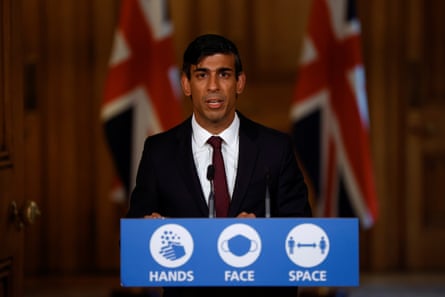 View image in fullscreenRishi Sunak in September 2020, presenting his winter economy plan. Photograph: WPA/Getty Images
View image in fullscreenRishi Sunak in September 2020, presenting his winter economy plan. Photograph: WPA/Getty Images
This, after all, is the institution responsible for botched privatisations and the mass sell-off of social housing. It has favoured international finance over national industry and built up vast off-balance-sheet debts. It has facilitated huge income inequalities, and sharp regional and generational inequalities have grown under its watch. And don’t forget all those market bubbles that it either ignored or fuelled.
Whether consciously or not, the Treasury’s elite appointees have acted as a sort of advance guard for the implementation of many of the neoliberal ideas and practices that organise the UK economy today. When all is said and done, the exchequer did as much to bring about Brexit as did lying, populist politicians and billionaire newspaper owners. They didn’t want it (well, Rishi Sunak did) but they sowed the seeds for it over many years.
Over the past few years, in the course of my research on the Treasury, I have interviewed 55 people connected with the institution, including every chancellor from 1979 to 2019 (except John Major, who occupied the role from 1989 to 1990), and every permanent secretary of the Treasury since 1983. The more I have studied the institution, the more I have become aware of its contradictions.
For one, it is a finance department and an economics ministry. Its traditional primary remit is to take control of the government’s budget. That means it is engaged in an ongoing, sometimes brutal battle to restrict department spending. Sir Tom Scholar, the current Treasury permanent secretary, sees this as the institution’s most crucial role. “Things have got to be paid for, whether by taxation, spending reallocation or borrowing,” he told me. “Everything somehow in the end has got to be paid for.”
At the same time, the Treasury is also responsible for wider economic policy, which often requires spending from those same departments. This has led some to argue that the Treasury should be split into two departments of finance and economics, as in Germany and the US. When I spoke to Vicky Pryce, a former head of the government economic services, she argued that the Treasury lacks real knowledge of particular sectors – welfare, energy, climate change etc – but refuses to recognise this. “The Treasury generally thinks that they can handle it all.” In her view, “the Treasury should just be the finance department”.
Another contradiction: the Treasury must guide national economic policy, but since the 1970s, the predominant Treasury consensus has been that the economy is best served by keeping the state out of all forms of economic management. This belief goes well beyond selling off nationalised industries and other state assets. The Treasury tends to be reluctant to support regional development, or to favour national industries in trade negotiations, or to invest in grand infrastructure projects. This position has intensified in recent decades. “The Treasury knows that it doesn’t know best, so better to leave decisions to markets,” is how Nicholas Macpherson, the Treasury permanent secretary from 2005-16, put it.
Similarly, although responsible for boosting the whole of the UK economy, the Treasury is very much rooted in central London and has limited knowledge of regional economies and non-financial industries. Kenneth Clarke, former chancellor, told me being in the Treasury “was like being on the high table at an Oxbridge college composed of brilliant people, none of whom would have been capable of running a whelk stall, because they didn’t have much experience of the real world in a hands-on way”.
 View image in fullscreenChancellor Kenneth Clarke in 1996. Photograph: Kevin Lamarque/Reuters
View image in fullscreenChancellor Kenneth Clarke in 1996. Photograph: Kevin Lamarque/Reuters
The last contradiction worth teasing apart is the contrast between the view of the Treasury as driven by key personalities (a view endorsed by many former chancellors) and the view of the Treasury as guided by data and the impersonal forces of economics (a view preferred by many economists). According to the former view, economics is subordinate to politics. When I spoke to George Osborne, he put it like this: “At the heart of almost all domestic political decisions are basic questions of who are you taking money from and who are you giving money to. That’s not really economics; it actually goes to the heart of how you organise a society … So, in the end I always thought of them more as sort of social judgments rather than economic judgments.”
A different view emerges from formal Treasury publications and academic studies that focus on financial trends and procedures. In these, the Treasury is a sort of central processing hub, managing inputs of hard data and ever-more sophisticated economic models, all deployed to observe and respond to economic conditions. This world is one of logical decisions, formal institutional practices, complex algorithms and advanced processor power, in which human decisions play a diminishing part.
The problem with this more abstract view of the Treasury is that it conveniently enables those involved in making decisions to hide behind faulty models and unmanageable markets and global economic forces, as if nothing they did was ultimately under their own control. But the recent history of the Treasury, and the British economy, tells a different story. Nothing was inevitable. Groups of individuals made choices, often based on the dominant economic norms of the time, and often in response to political or financial expediency, though sometimes with grander idealistic goals in mind.
Much of the time, however, there was no grand plan. Some of those I spoke to admitted that they hadn’t thought through certain ideas or how key policies would result in the significant outcomes that followed. They showed a certain amount of remorse about the eventual pathways taken. Others simply wanted to defend their decisions at the time and preferred to dwell on more positive results. Others still, who watched rather than participated, were eager to condemn key decisions and policies from afar. Hardly any of them, however, would have predicted then how things were to turn out now.
Since the 2016 Brexit vote, the Treasury has experienced a rapid decline and then a renewal of fortunes. The decision to leave the EU marked the collapse of four decades of economic policy consensus, the breakdown of the British establishment, and was a direct hit to Treasury power. Into the power vacuum walked Boris Johnson and a makeshift alliance of politicians, media moguls and corporate leaders, who had all seen the EU referendum as an opening too good to miss. Nothing was going to get in their way, and certainly not the Treasury and its orthodoxy.
Brexit devastated the Treasury on multiple levels, some more visible than others. One senior official’s account of what was happening inside the institution the day after the vote reveals the sense of chaos and disarray that followed: “There were a lot of people in tears. There were a lot of people who did take it as a personal criticism. George Osborne disappeared. We didn’t see him again until the following Monday. The prime minister resigned. So, by 9.30am on the day of the biggest political shock in modern British history, we didn’t have a chancellor because he’d gone awol, but the prime minister had just resigned. It was kind of bizarre. The adult, the supervising adult for the financial system was [governor] Mark Carney, who had made an extremely accomplished, almost presidential statement from the Bank of England. Nobody understood what it meant, but he had a very big number.”
The Treasury found itself on the losing side of a huge fight. For one senior adviser at the time, the exchequer remained in denial for some time: “They were feeling Brexit was the wrong decision for the country. And I spoke to one very senior official whose plan basically was to drop out of the EU, into the EEA for a few years, and then rejoin the EU.”
With the Brexit vote, the Treasury lost its dominant, facilitating position in national economic management. A vote for Brexit was also a vote of no confidence in economic experts and Treasury authority. The Treasury was now one player among many, jostling with enemies on all sides.
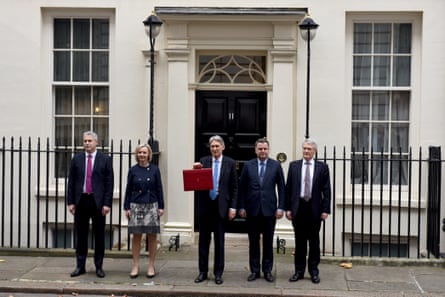 View image in fullscreenChancellor Philip Hammond, centre, with Treasury secretaries (l to r) Stephen Barclay, Liz Truss, Mel Stride and Andrew Jones in 2017 before presenting the government’s autumn budget. Photograph: Kate Green/Anadolu Agency/Getty Images
View image in fullscreenChancellor Philip Hammond, centre, with Treasury secretaries (l to r) Stephen Barclay, Liz Truss, Mel Stride and Andrew Jones in 2017 before presenting the government’s autumn budget. Photograph: Kate Green/Anadolu Agency/Getty Images
Many of Britain’s business and financial elite, despite their strong concerns about leaving the EU, had been reluctant to get involved in the 2016 remain campaign. After the leave vote, they were equally unwilling to make the case for a soft Brexit. As several in and around the Treasury told me, CEOs constantly turned up, armed with alarming research to lobby against leaving the EU and a hard Brexit. But they didn’t say that in public. “That drove me mad,” one adviser told me. “They’d come into the Treasury, and they’d complain and complain and complain. They’d provide this sharp harsh data, and we’d think great, write a letter, publish it in the Times. ‘Oh, we can’t do that.’ They didn’t want the risk … from a business perspective they’d done the right thing, but they all came in and complained.”
Under Cameron’s successor, Theresa May, the antagonism between Number 10 and the Treasury grew. No one, including then-chancellor Philip Hammond and all the advisers and officials I talked to, quite knew what May’s intentions were on Brexit. They were all blindsided by her “Brexit means Brexit” speech, her decision to trigger article 50, and shocked by her lack of understanding of the economic implications of leaving the single market. Hammond continued to battle for the status quo – namely, balancing the budget and aiming for the softest Brexit possible.
However, May, pushed on by the Brexiters and her aides Nick Timothy and Fiona Hill, instead veered towards a hard Brexit. They also directly challenged the Treasury, attempting to wrest control of economic policy from it. “Nick Timothy genuinely hated the Treasury, genuinely hated us and saw us as the root of all evil,” one top official claimed. “His creation of BEIS [the Department for Business, Energy and Industrial Strategy] was a straight-up attack,” that was intended “to pull the economics part out of the Treasury”.
By the end of 2016, the Treasury and Hammond looked increasingly isolated. Few were prepared to take their side within Westminster. They seemed to be hanging on by default amid the wider turmoil of government.
The exchequer does crisis exceedingly well, and three major crises have aided its recovery from its 2016-17 nadir. The first, devastating to the nation’s politics, was the June 2017 election, which left May’s government without a working majority, effectively paralysing Westminster. The second, devastating to its health, was the 2020 arrival of Covid. The third was more localised and personal, but no less significant: partygate and the subsequent collapse of Johnson’s support.
The 2017 election result, debilitating as it was for May, probably saved Hammond’s position as chancellor and the exchequer from a more major assault. Instead of Hammond being sacked, as had been widely touted before the election, it was Timothy and Hill who were dispatched. May found that Hammond was rather easier to deal with than the hardline Brexiters now taking up cabinet seats. As a senior official reflected: “Hammond was basically the only member of the cabinet that remained consistently loyal and respectful to her and didn’t brief against her.”
The Treasury also regained a degree of economic authority. This was partly because none of the department’s enemies offered an alternative economic vision. As one former economic adviser states: “Brexiters like Boris basically had no coherent position or argument, frankly. They didn’t understand the tradeoffs that were inherent in Brexit.”
Hammond and the Treasury were then able to regroup and continue pursuing the as-you-were strategy of balancing the budget, maintaining international investor confidence and pushing for a softer Brexit. Although they eased up a bit on deficit reduction, Hammond was entirely attuned to the previous orthodoxy. He had backed the cuts strategy of the coalition before, and strongly believed in retaining access to the single market now.
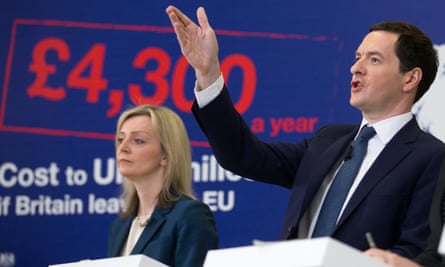 View image in fullscreenGeorge Osborne with Liz Truss in 2016, warning against Brexit. Photograph: Matt Cardy/Getty Images
View image in fullscreenGeorge Osborne with Liz Truss in 2016, warning against Brexit. Photograph: Matt Cardy/Getty Images
When, after three and a half years of Brexit stalemate, May was finally toppled by Johnson, the new prime minister proceeded to purge many of May’s ministers and then won a clear majority at the election at the end of 2019. He consolidated his position by hacking away at any dissenting establishment institutions and voices, from parliament to the judiciary and the BBC. A hard Brexit was achieved. He made a point of firing any cabinet colleagues who might offer a hint of opposition. “We all know what happens if you say no to the prime minister,” as one former Treasury adviser put it to me. “You get whacked.”
Sajid Javid, Johnson’s first chancellor and a popular figure in the Treasury, was whacked less than six months after being appointed. Sunak, then just another unknown Goldman Sachs graduate, fell into line. According to officials, Dominic Cummings, Johnson’s whacker-in-chief, was set on ejecting many senior mandarins, with Scholar, the Treasury permanent secretary, at the top of his list. Then, just as Cummings was preparing the hits, Johnson, in true Robert De Niro style, clipped Cummings instead.
Surprisingly, once he was secure as PM, Johnson dropped his attacks on anti-Brexiters and Whitehall. Peerages were quietly doled out and whips restored. Peace was made with Number 11. Once Johnson became prime minister, one mandarin told me, he “actually worked well with the Treasury”.
Key to this improved relationship was the fact that the Treasury and its new chancellors, Javid and then Sunak, accepted Johnson’s Brexit and big spending agendas. After the 2019 election, Johnson made great efforts to distinguish his administration from Cameron’s and May’s with tens of billions of additional public spending and by setting up an infrastructure investment bank. (I asked several Conservatives to explain this sudden shift of party and exchequer policy. Some talked of “levelling up” and the need to secure northern seats gained from Labour in 2019. For others, the spending had no larger economic policy coherence, but was purely about changing the Tory brand and maintaining Johnson’s appeal. As one adviser put it: “He tells everybody what they want to hear.”)
On the Brexit side, talking to those in and around the Treasury in 2021, there appeared to be a greater willingness to engage with the leave position. Voting leave hadn’t made much sense to them at the time. They now acknowledged the issues of sovereignty, immigration and regional economic disparities, keenly felt beyond the London bubble. A new office is being set up in Darlington with an expectation of eventually employing 200-300 Treasury staff there. There was also a recognition that austerity had gone on too long and that there was a need to actively support those regions left behind.
And then, just as the officials in the Treasury were starting to feel distinctly uncomfortable with the new grand outlays, there came the Covid pandemic. This event, probably the most devastating for the general public’s lives since the second world war, was punishing for the Treasury, and one of its finest hours.
As the crisis began, Sunak’s exchequer moved remarkably quickly. Senior officials combined with the Bank of England to dream up solutions to problems they had never considered. “Some countries have existing furlough schemes. We had nothing,” one official admitted. “We didn’t even know what the name meant.” Another Treasury interviewee emphasised the sheer scale of what was done:
“Our tax teams and HMRC invented and implemented furlough at incredible speed. At its peak, we had a third of the British workforce on our payroll. We were paying 80% of the salaries of nearly 10 million out of a workforce of 30 million. We created a whole new large corporate banking capability from scratch, which no one’s really noticed. With the Bank of England, we extended £100bn of credit facilities for larger companies. We guaranteed several multibillion-pound loans to strategically important UK companies to support them through the crisis. With BEIS and the British Business Bank, we guaranteed new small business lending supporting over 1.5m SMEs. And we did it all with our colleagues working remotely from their bedrooms, living rooms and kitchen tables.”
Between Brexit and Covid, the Treasury once again became indispensable. As well as dealing with economic support schemes during the pandemic, post-Brexit it also had to cover gaps in trade policy, tariffs, financial services regulation and competition policy. Under Nicholas Macpherson, Treasury headcount had been steadily reduced to just under 1,200 people. Expanding to deal with the new functions pushed that back up to over 2,000.
And, as with previous crises, with many urgent demands on government funds, the Treasury’s hand was strengthened by holding the purse strings. Whatever Johnson and other cabinet ministers thought of the department, they were too reliant on its abilities and practical administrative tools to take it on. As one former adviser put it: “There is now a certain level of co-dependency … in a way Covid sort of saves their political union.”
But as the effects of the pandemic stretched out into a second year, tensions began to build. The question was how long the Treasury would be prepared to maintain such levels of emergency spending, let alone be willing to fund Johnson’s agenda. Large parts of the private sector were suffering from the impacts of Brexit, Covid or both. Similarly, many parts of the public sector were in desperate need of greater resources to maintain vital services. As Scholar reflected: “I think there are big questions confronting the Treasury and the chancellor. One is what to do about all of the debt that’s been incurred in the last 18 months, over what timeframe and with what target to start … Every country in the world’s got that question.”
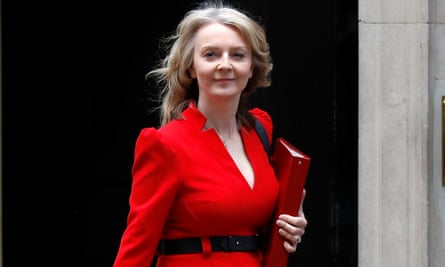 View image in fullscreenLiz Truss in 2019, when chief secretary to the Treasury. Photograph: Peter Nicholls/Reuters
View image in fullscreenLiz Truss in 2019, when chief secretary to the Treasury. Photograph: Peter Nicholls/Reuters
Speaking to another senior official, his cheery demeanour disappeared as he reeled off the impossible list of essential things to be funded: “We’ve got a huge health backlog. Getting to net zero isn’t free … levelling up, big investment, depending on what it is, but the deprived communities are not going to think levelling up means anything unless they see some money that they wouldn’t otherwise have seen. And we’ve also got rising debt interest on the bigger stock of debt … and we’ve got an ageing population. So, you can make yourself all quite gloomy on the fiscal outlook.”
Towards the end of 2021 it looked as though a showdown was coming. Johnson and the big spenders would declare new measures for levelling up. The Treasury would respond with an empty coffer. Then came partygate, Johnson’s plummeting poll ratings, a leadership contest and now a new prime minister, Liz Truss. As so often in the past, and again now, when crises hit, the Treasury reverts to it default position of harsh cuts and budget balancing. The fallback position of aspiring Tory leadership contenders – and neither Truss nor Sunak were different here – is a return to 80s Thatcherism (tax cuts, union bashing and deregulation). The combination suggests that in early 2022, the exchequer was returning to full strength. That was until inflation soared, Russia invaded Ukraine, energy costs shot up and a widespread cost of living crisis threatened devastating consequences. The immediate Covid crisis was under control but the urgent need for large-scale emergency government spending remained.
Thus, the Treasury’s position remains very precarious, highlighted by Truss’s attacks on it during the Tory leadership election. There are a number of wider intellectual and social challenges ahead. These all strongly contest the key elements of Treasury orthodoxy and mainstream economic policy that have been widely adopted in many nations: free trade, free markets, monetary over fiscal activism and balanced budgets.
One clear Treasury principle, which seems to have been undermined by recent global events, is that of internationalism and free trade. Since the financial crisis, protectionism has grown globally, with the World Trade Organization being sidelined and many international trade disputes following. Brexit was the UK’s very public rejection of certain aspects of globalisation. Since then, Covid has put further barriers up as nations have tightened borders and restricted movement, as well as competing aggressively over vaccine production and distribution.
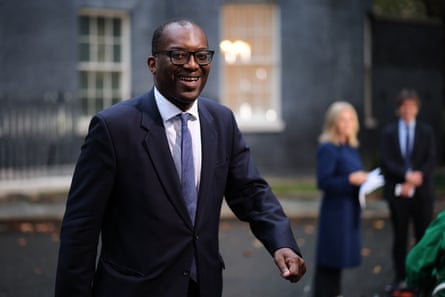 View image in fullscreenThe new chancellor, Kwasi Kwarteng. Photograph: Rob Pinney/Getty Images
View image in fullscreenThe new chancellor, Kwasi Kwarteng. Photograph: Rob Pinney/Getty Images
The pandemic also revealed that too much dependence on international supply chains was extremely problematic amid a global crisis. “We couldn’t even manufacture a plastic glove in the UK. And so, we had a shocking dependence on PPE from around the world,” one Treasury official told me. “Treasury orthodoxy before would have been: ‘Oh well, you know, free market, it’s protectionism to have national preference, you can always buy these plastic guards from the cheapest provider, and someone will make them somewhere else.’ But I think it’s a bit of a wake-up call for all of us.”
More generally, the wider intellectual rationales that have guided UK economic policy, as in many capitalist economies, appear increasingly confused. Governments everywhere have intervened in their economies to degrees unprecedented since the second world war. This goes against decades of consensus about the limits of state economic intervention. Such interventions, adopted during the 2007-08 financial crisis, were supposed to be temporary and later unwound. They weren’t. Now similar actions, from huge government bond buying by central banks to emergency funding of the private sector, make the temporary the norm. For the economist Daniela Gabor, the new financial shift means that “we are living through a revolution without revolutionaries … Central banks have quietly put in place a shadow monetary financing regime since the global financial crisis.”
And behind all this lurks the issue of rising inflation to levels not seen since the 70s. Textbook monetarism says that interest rates need to rise to head off inflation, but even the modest rises happening now will have a very hard impact on the economy and a public struggling to eat and heat their houses while seeing their mortgage rates soar. Quite apart from inhibiting future economic recovery, ballooning individual, corporate and government debt levels, already huge prior to Covid, will become unserviceable. The resulting economic crisis could be worse than in 2007-08.
The real Goldfinger: the London banker who broke the worldRead more
Such dilemmas, of course, reach far beyond the UK. But the UK and the Treasury, like many other nations and finance departments, must be wondering how to cope and how to retain credibility. Sticking to conventional economic thinking of the kind that has dominated since the late 70s does not seem sustainable. In fact, the actions of central banks and finance departments everywhere demonstrate that the iron economic certainties of mainstream economic policy have, in a crisis, proved to be as malleable as soft butter. What comes next under Truss and her chancellor, Kwasi Kwarteng – radical paradigm shift, return to an unworkable system, fantasy economics, or decline into something worse – is anybody’s guess.
This is an edited extract from Bankruptcy, Bubbles and Bailouts: The Inside History of the Treasury Since 1976 by Aeron Davis, published by Manchester University Press on 18 October and available at guardianbookshop.co.uk
Follow the Long Read on Twitter at @gdnlongread, listen to our podcasts here and sign up to the long read weekly email here.




Leave a Reply
You must be logged in to post a comment.